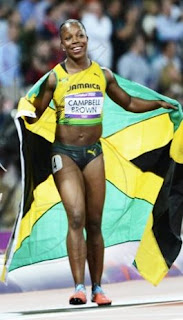The National Senior Championships of 2013 may not
have brought out the crowds of 2012, but the die-hards probably didn't notice
or care. Our minds were fiercely concentrated on the highs and lows of each
moment. This die-hard could only afford one day at the National Stadium,
Saturday, but the television coverage was pretty decent so I only missed the
vibes of the crowd. I would guess that most persons saw the obvious victories
and the noticeable absences of those “big-names”.
 |
| Natoya Goule Photo by Ricardo Makyn Gleaner Staff Photographer |
What struck me most intensely was the very smooth
changing of the female guards, the woman constables. Some we can expect to
continue running on the European circuit for the rest of the season just as
others, I suspect, may see these trials as the final curtain call on their
athletic careers.
We crossed our fingers and toes for soldier-girl
Aleen Bailey but knew in our hearts that these National Championships may well
be her swan song. This constant of Jamaica's track and field ran 7th in
women's 100 metres final but don't be fooled, she did so at the IAAF 'A'
standard. Aileen's 200 metres 6th place was however just outside the 'B'
standard.
We watched as the women's 100 metres hurdles gave us
our own Williams sisters and at the same time Delloreen Ennis-London, at
thirty-eight, just missed out on a spot in 4th place. Note well, the top four
women in this event made the IAAF 'A' standard, so Deloreen's 12.94 seconds is commendable.
My personal favourite was the women’s 400 metres
final which had everything I could hope for in the one lap sprint. It
demonstrated that we have the talent to go forth and build, but build with
ardor we must. Novlene Williams-Mills sent a bold message that the young team
will need experience and leadership to take on the world, so she went
commandingly to the head of the line. What a finish, what a talent.
 |
| Novlene Williams-Mills Photo by Ricardo Makyn Gleaner Staff Photographer |
Of great significance is the performance of
Stephanie McPherson, who ran a season’s best of 50.16 seconds behind Novlene,
and who in her own words is “getting faster and stronger” ('I'm getting faster and stronger' -
McPherson targeting 49.10 by Ryan Jones Gleaner Staff Reporter May 6,013). It certainly wasn’t lost on me that Novlene
was the only one of the Bronze winning 4x400 metres quartet from the 2012
Olympics that made the team for Moscow. Whilst there are more races left in the
likes of Rosemarie Whyte, Shericka Williams and Christine Day, it also wasn’t
lost on me that the average age of the final eight was/is 26.75 years old. We
therefore have much work to do to maintain balance between youth and experience
going into 2015/2016/2017. Novlene is thirty-one years old, and this win was as
sweet for her as it was tough.
In June 2012 I wrote of Ristananna Tracey, “If she
remains healthy and fit, with time and experience, she will be called upon to
carry the torch in 2016”. I continue to believe this and I am delighted to see
her steady progress. The top three 400 metres hurdles finalists all surpassed
the IAAF ‘A’ standard of 55.40 seconds, with 4th, 5th and
6th places comfortably meeting the ‘B’ standard of 56.55 seconds. If
you didn’t notice, Kaliese Spencer’s 51.65 seconds 6th place in the
400 metres was only 0.10 seconds below the ‘A’ standard, a very positive
indicator for the 400 metres hurdles. Let me not fail to point out that the average
age of the eight finalists plus Kaliese is 23 years old. Stay healthy and
navigate injuries judiciously then watch the ride down the road.
I continue to bemoan the shallow pool of talent
after 400 metres. I was among those cheering boisterously on my feet for Natoya
Goule as she not just made the IAAF ‘A’ standard but a sub-2 minutes personal
best at 1:59.93 in the 800 metres. Even
more striking than the absence of the event’s standard bearer, Kenia Sinclair,
is the fact that of the (only) three others in the race none made the IAAF ‘B’
standard.
I am not at this stage making any comparisons to any
other country’s results, especially not the USA. My intent was to draw attention
to the subtle changing of the guards in the ranks of our female athletes. We
have work to do JAAA’s, in shoring up the bench for the short sprints. Beyond
400 metres we need to dump or get off the pot, it’s inconceivable to me that we
cannot produce more than one or two middle distance runners per generation. In
the last 20 years only two names have stood out at 800 metres, Kenia Sinclair
and Inez Turner, now we hang our hopes on Natoya Goule.
With a few short weeks to go to the World Championships
in Moscow, much work will take place away from the eyes of the very demanding
local and global publics. Jamaica will be called upon to deliver both
entertainment and results.
Heads high, Team Jamaica, we’ve got your backs.

